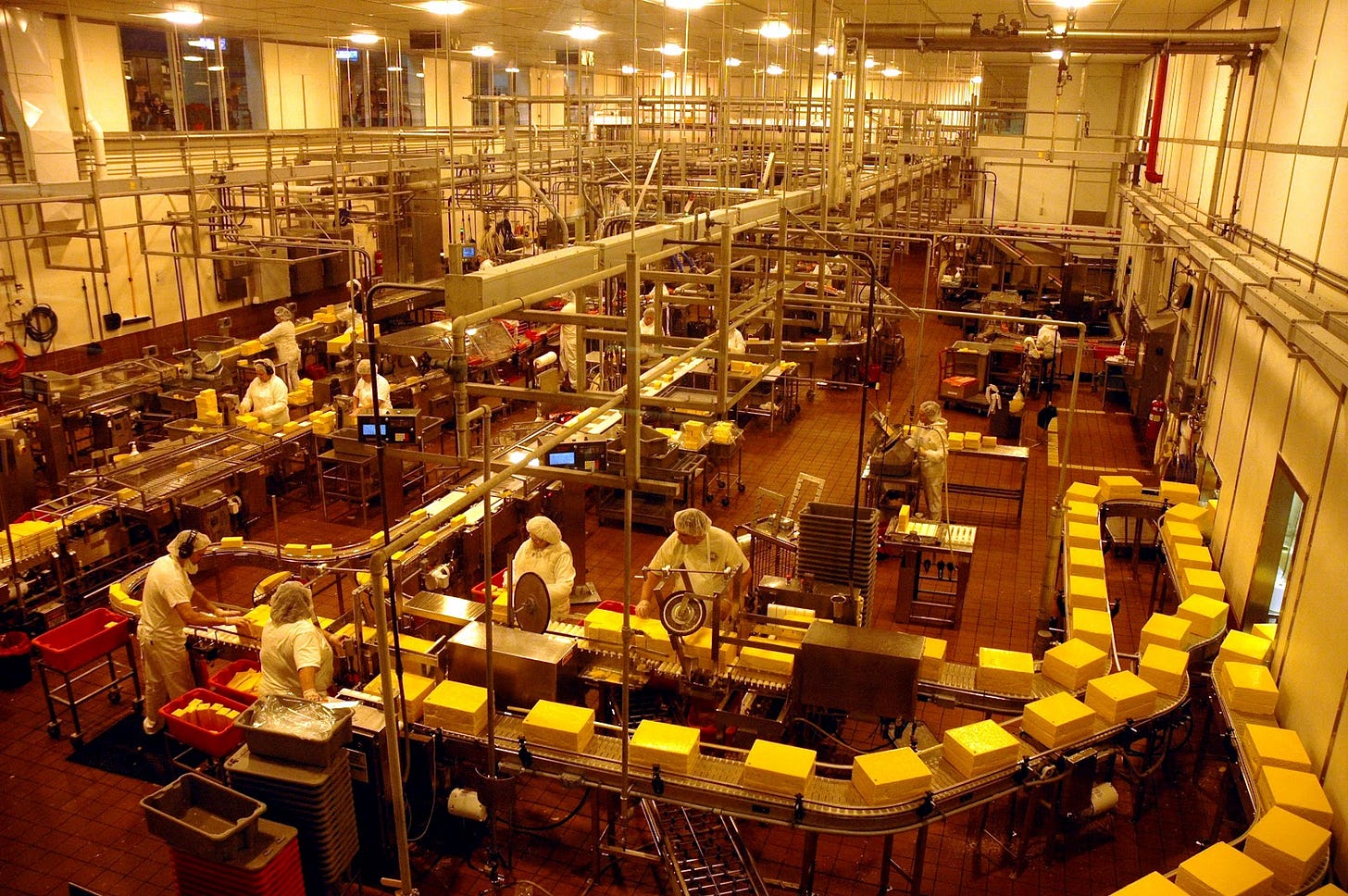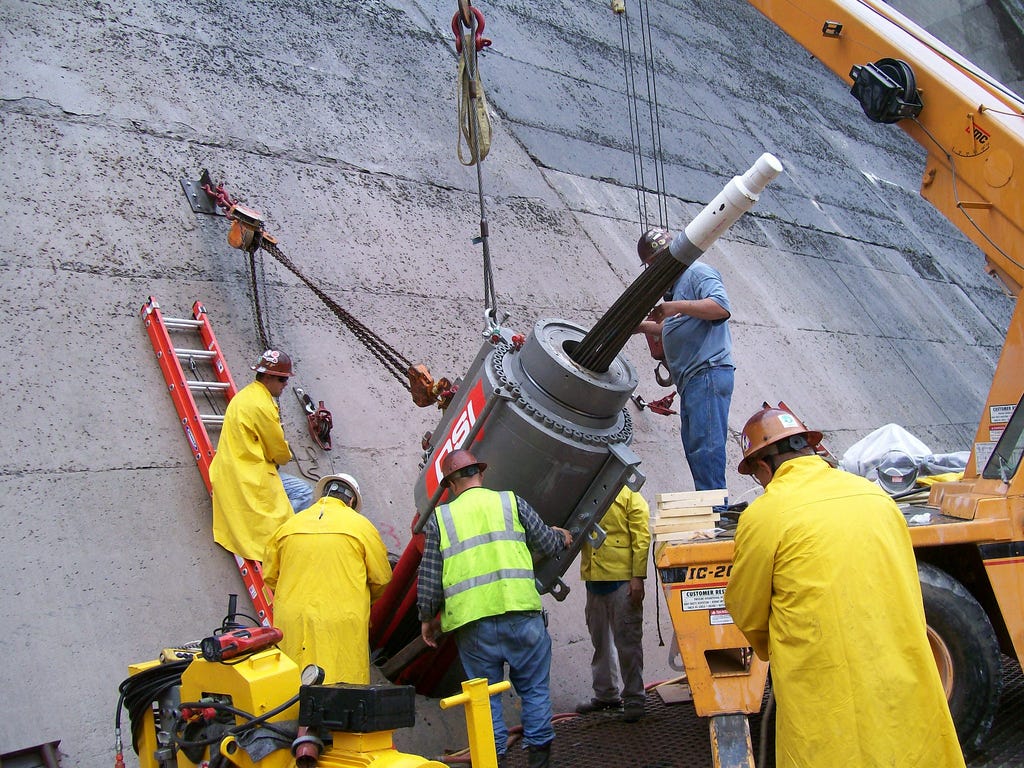Organizations allow humans to cooperate at a higher scale
People work together using a wide variety of skills and technologies to accomplish a common goal.
Make someone’s day: Gift a subscription to your friends and family!
In this series of articles, I focus on How Progress Works. Once the Five Keys to Progress create the necessary pre-conditions for progress, societies become a vast decentralized problem-solving network that generates progress. So far I have discussed a few of the factors in how progress works:
Technological innovation. This includes radical innovations such as the railroad, electrical grid, computers and the internet, as well as the ongoing incremental improvement and differentiation of thousands of other existing technologies.
People learning new skills to support those technologies. Without these skills, technologies are not useful, a fact that is often forgotten.
Today’s topic is the third factor in how progress works: People cooperating within organizations. Those people work together using a wide variety of skills and technologies to accomplish a common goal.
The following is an excerpt from my book From Poverty to Progress: Understanding Humanity’s Greatest Achievement. You can purchase discounted copies of my book at my website, or pay full prize at Amazon.
Other books in my “From Poverty to Progress” book series:
Social Organizations Knit Together Technologies and Skills
So far, we are left with the following: to achieve progress, we need technological innovation. To achieve technological innovation, we need skills. As the number and complexity of technologies accelerate, people need to specialize in a small number of skills. So technological innovation and progress fragment us into more specialized professions, each with clusters of related skills. But something is required to knit these specialized workers into a team that can produce a technology or service.
As shown by Robert Wright in Nonzero: The Logic of Human Destiny (summary here), that something is a social organization. Social organizations have existed throughout human history. The family, bands, tribes and nations are just some of the social organizations that humans have lived within. In modern times, social organizations have formalized into institutions, for example, governments, corporations, labor unions, churches, militaries, non-profits and many more.
For progress and technological innovation, corporations are the most important institution. Corporations knit together people with many different skills into one organization based on a business model designed to sell a small set of products or services to a specific customer base. Because each corporation has different technologies and different customer bases, each corporation evolves its own business model to succeed in that environment. Because customers have a limited amount of money, corporations are forced to compete with other corporations to survive.
In this way, a corporation, like all social organizations, is much like a biological organism. While biological organisms compete for energy and nutrients, corporations and other institutions compete for revenue.
To survive this competition for revenue, corporations must adopt technologies, employ people with skills appropriate to those technologies and adopt processes that organize those people towards a common mission. Corporations that do this successfully will tend to acquire increased revenue. Those that fail to do so will tend to acquire less revenue. The worst will go bankrupt.
As technologies become increasingly more complex, requiring a greater number of specialized skills, corporations and other institutions must also become more specialized and complex. Traditional societies have a relatively small suite of technology, so they require only a few small organizations. Modern societies, however, have an enormous suite of technologies. This requires a vast number of complex social organizations, each specialized in narrow domains of technologies or services.
Humans Are Unique In Our Complexity of Cooperation
All social animals cooperate in groups, but they all cooperate in groups that are virtually identical to each other. If you understand the dynamics of one pride of lions or one school of herring, you can presumably understand the dynamics of all prides of lions and all schools of herring. Non-human animals have almost no diversity in the type of groups in which they are associated.
Humans cooperate in families, bands, clans, tribes, nations, empires, corporations, labor unions, charities, schools, churches, hospitals, factories and numerous other types of organizations. Each of these organizations has different characteristics because humans voluntarily formed them to solve different problems. As far as I know, there is no analog in the animal kingdom.
In addition, a single individual human can cooperate in many different groups at the same time. I can cooperate within my family, my neighborhood, my metro, my nation, the company of my employer, my labor union, my favorite charity, and my church at different times. Modern humans naturally do this all the time without thinking much of it. This too has no known analog in the animal kingdom.
Prices
The mechanism that links these individual social organizations into a much larger problem-solving network is transparent, free-floating prices.
Prices give incentives and they communicate information. If the price of an item or service is high enough that businesses can produce more of it while earning a profit, this communicates that the good or service is scarce. It also gives a strong incentive for an organization to form to deliver that good or service. If the price of an item is so low that those who produce it can barely make a profit, this discourages organizations from doing so.
A key benefit of prices and markets is that they shift the focus from solving one’s own problems to solving other people’s problems. Markets are often accused of encouraging selfish behavior, but they strongly encourage actions that benefit others.
Humans in modern societies solve their own problems, but, surprisingly, they do so by solving other people’s problems first. Prices communicate which problems other people think need to be solved. People will pay more for a good or service that solves a more serious problem, so prices encourage them to solve their own problem (putting food on the table) by helping other people solve their problems.
Of course, what I am describing is a classic free market as described by economists. But free markets, in themselves, cannot deliver progress. It is only with the Five Keys to Progress that markets can do so.
Markets existed during Hunter-Gatherer times. While they undoubtedly enabled people to trade for scarce raw materials like obsidian, there is no evidence that the result was anything resembling progress. If free markets had suddenly popped into existence in the 14th Century Incan empire, or the 10th Century Carolingian empire or in the 20th Century Congo or Somalia, there would have been no progress as a result.
Prices and markets are mechanisms by which the Five Keys to Progress enable cooperation over long distances, but they cannot deliver progress alone. However, as soon as the five keys join together in one society, markets with their pricing mechanism can enable progress.
Positive Feedback Loop
We have seen how technological evolution drives the acquisition of more specialized skills, which in turn drives the evolution of more specialized and complex social organizations. So just as biological evolution tends to create a greater number of species in a complex environment, cultural evolution and progress has the same effect on human societies.
But within this process, there are feedback loops that make progress even more dynamic. Humans do not just passively learn skills related to new technologies. They also push back to make the technology easier to use.
In my profession as a User Experience Designer in the technology field, I design the software that software developers write the code for. A key part of my job is to make complex technologies easy to use.
Early in the history of digital technology, business leaders expected users to be able to use technologies as they were provided. As long as a specific piece of technology was functional and performant, they thought the technologies would sell. As a result, early software was very difficult for novices to use.
Gradually customers and businesses pushed back on software companies and demanded that their products be made easier to use. More often, they just stopped buying the product and the software companies wondered why.
A few software companies, particularly Apple Computer, realized that software products needed to be designed for ease of use. In addition, technologies were invented to make user experience design more feasible at scale. The iPhone, Cascading Style Sheets and the Webkit browser engine played a particularly important role.
The combination of new technologies and design skills gave birth to my profession. The result is that the software market broadened beyond experts and gradually computers became something that users wanted to use in their homes.
And it was not just individual consumers who forced the software industry to adapt. Corporate consumers of software demanded that the product mesh with their overall business processes. Corporations were willing to invest in improving the productivity of individual departments, but if the output fundamentally disrupted the productivity of a dozen other departments, the cost was too great. So, just as software companies were forced to adapt to the skills of typical users, they were also forced to adapt to the processes of social organizations.
So while technological innovation forces society to adopt new skills and social organizations, the people with those skills and the people within those social organizations also forced additional rounds of innovation. The result is a feedback loop where innovations drive more innovations.
When new corporations are created to produce and use new technologies, those organizations put enormous pressure on existing corporations that produced or use older competing technologies. In many cases, these older companies were titans of industry that looked like they would dominate their sector for generations to come. But when a new technology evolves, seemingly dominant corporations can quickly be put out of business or at least radically diminished in their market share.
In theory, dominant corporations can simply adopt the new technology, but in practice, the skills and processes of the older technology may be so different from the skills and processes of the new technology that it is not easily done. Just like animals, big organizations built to survive in a certain environment cannot quickly adapt to major changes in that environment.
Changing the corporation so that it can produce or use new technologies may force widespread cultural changes that are strongly resisted from within. Typically, the established corporation is making enough money on the old technology that they do not even think that radical change is necessary.
The existential threat of the new technology does not become obvious until after revenues start to significantly decline. Just as older corporations need additional revenues to make the change, their revenues decline significantly. This often forces the once dominant company into a death spiral that leads to bankruptcy.
When an important new technology is innovated, it creates not just a few companies but an entire industry. In some cases, the new technology spawns dozens of new industries, each dedicated to building the components and sub-components of the new technology.
The invention of the automobile is a classic example. The automobile industry grew from a gaggle of small car companies to a vast sector of the economy with hundreds of large, medium, and small companies building tires, brakes, steel, glass, along with a legion of specialized repair and parts shops.
In the next article in this series, I explain the importance of competition between organizations for scarce resources.
The above is an excerpt from my book From Poverty to Progress: Understanding Humanity’s Greatest Achievement. You can purchase discounted copies of my book at my website, or pay full prize at Amazon.
Other books in my “From Poverty to Progress” book series:
You can learn more about How Progress Works with these links:
People learning new skills to support those technologies.
Competition between organizations for scarce resources.
People copying successful technologies, skills, and organizations and then modifying them to solve different problems.
Consumption of vast amounts of useful energy.







